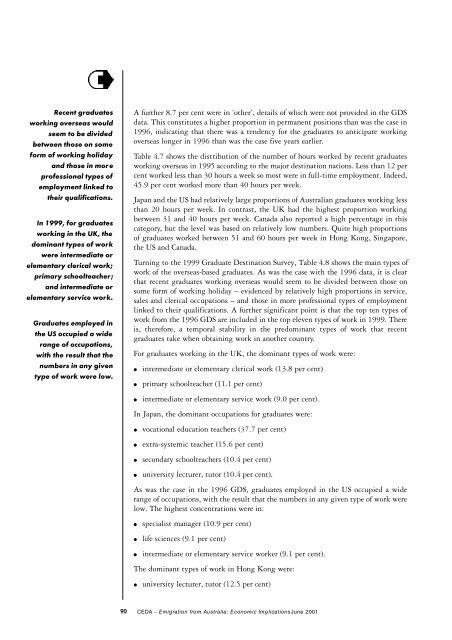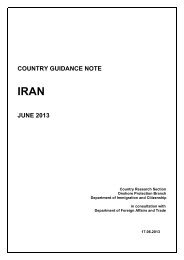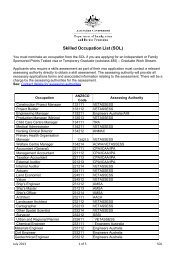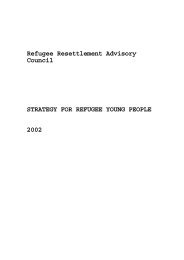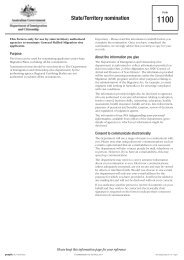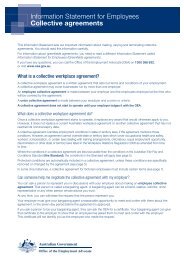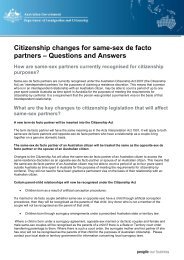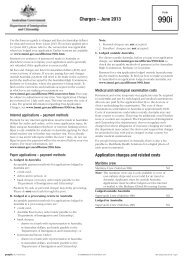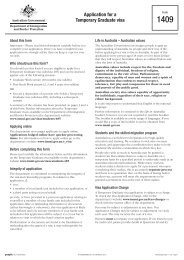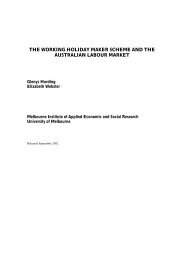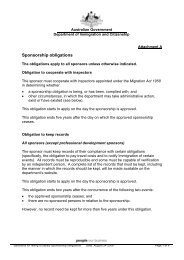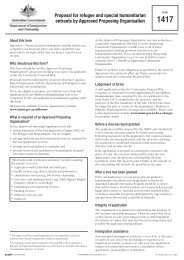part three - Department of Immigration & Citizenship
part three - Department of Immigration & Citizenship
part three - Department of Immigration & Citizenship
Create successful ePaper yourself
Turn your PDF publications into a flip-book with our unique Google optimized e-Paper software.
Recent graduates<br />
working overseas would<br />
seem to be divided<br />
between those on some<br />
form <strong>of</strong> working holiday<br />
and those in more<br />
pr<strong>of</strong>essional types <strong>of</strong><br />
employment linked to<br />
their qualifications.<br />
In 1999, for graduates<br />
working in the UK, the<br />
dominant types <strong>of</strong> work<br />
were intermediate or<br />
elementary clerical work;<br />
primary schoolteacher;<br />
and intermediate or<br />
elementary service work.<br />
Graduates employed in<br />
the US occupied a wide<br />
range <strong>of</strong> occupations,<br />
with the result that the<br />
numbers in any given<br />
type <strong>of</strong> work were low.<br />
A further 8.7 per cent were in ‘other’, details <strong>of</strong> which were not provided in the GDS<br />
data. This constitutes a higher proportion in permanent positions than was the case in<br />
1996, indicating that there was a tendency for the graduates to anticipate working<br />
overseas longer in 1996 than was the case five years earlier.<br />
Table 4.7 shows the distribution <strong>of</strong> the number <strong>of</strong> hours worked by recent graduates<br />
working overseas in 1995 according to the major destination nations. Less than 12 per<br />
cent worked less than 30 hours a week so most were in full-time employment. Indeed,<br />
45.9 per cent worked more than 40 hours per week.<br />
Japan and the US had relatively large proportions <strong>of</strong> Australian graduates working less<br />
than 20 hours per week. In contrast, the UK had the highest proportion working<br />
between 31 and 40 hours per week. Canada also reported a high percentage in this<br />
category, but the level was based on relatively low numbers. Quite high proportions<br />
<strong>of</strong> graduates worked between 51 and 60 hours per week in Hong Kong, Singapore,<br />
the US and Canada.<br />
Turning to the 1999 Graduate Destination Survey, Table 4.8 shows the main types <strong>of</strong><br />
work <strong>of</strong> the overseas-based graduates. As was the case with the 1996 data, it is clear<br />
that recent graduates working overseas would seem to be divided between those on<br />
some form <strong>of</strong> working holiday – evidenced by relatively high proportions in service,<br />
sales and clerical occupations – and those in more pr<strong>of</strong>essional types <strong>of</strong> employment<br />
linked to their qualifications. A further significant point is that the top ten types <strong>of</strong><br />
work from the 1996 GDS are included in the top eleven types <strong>of</strong> work in 1999. There<br />
is, therefore, a temporal stability in the predominant types <strong>of</strong> work that recent<br />
graduates take when obtaining work in another country.<br />
For graduates working in the UK, the dominant types <strong>of</strong> work were:<br />
●<br />
●<br />
intermediate or elementary clerical work (13.8 per cent)<br />
primary schoolteacher (11.1 per cent)<br />
●<br />
intermediate or elementary service work (9.0 per cent).<br />
In Japan, the dominant occupations for graduates were:<br />
●<br />
●<br />
●<br />
●<br />
vocational education teachers (37.7 per cent)<br />
extra-systemic teacher (15.6 per cent)<br />
secondary schoolteachers (10.4 per cent)<br />
university lecturer, tutor (10.4 per cent).<br />
As was the case in the 1996 GDS, graduates employed in the US occupied a wide<br />
range <strong>of</strong> occupations, with the result that the numbers in any given type <strong>of</strong> work were<br />
low. The highest concentrations were in:<br />
●<br />
●<br />
●<br />
specialist manager (10.9 per cent)<br />
life sciences (9.1 per cent)<br />
intermediate or elementary service worker (9.1 per cent).<br />
The dominant types <strong>of</strong> work in Hong Kong were:<br />
●<br />
university lecturer, tutor (12.5 per cent)<br />
90 C E DA – Emigration from Australia: Economic ImplicationsJune 2001


